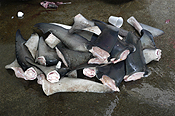Ocean Conservancy Applauds Shark Conservation Act of 2008
Congressional hearing today on bill that aims to end wasteful practice of shark finning

Today the House of Representatives Natural Resources Subcommittee on Fisheries, Wildlife and Oceans heard testimony on the newly introduced “Shark Conservation Act of 2008”, H.R. 5741, offered by Chairwoman Madeleine Bordallo (D-Guam), aims to end shark “finning” - the wasteful practice of slicing off a shark’s valuable fins and discarding the body at sea. Ocean Conservancy strongly supports the bill.
Shark fins, sought for the Asian delicacy shark fin soup are among the world’s most valuable fishery products. The discrepancy between high value fins and lower value meat creates an economic incentive to take just the fins. Demand for shark fins is a driving force in shark fisheries, most of which are unsustainable.
Finning was banned in the U.S. Atlantic in 1993; the Shark Finning Prohibition Act of 2000 established a national prohibition on the practice. Loopholes in the law have hampered enforcement while many fishing nations continue to allow finning.
The Act would strengthen the U.S. finning ban by allowing for better enforcement, encouraging other countries to adopt shark conservation programs that are comparable to the U.S., and establishing a process that would ultimately allow for sanctions against countries that do not.
Ocean Conservancy Shark Conservation Program Director, Sonja Fordham, offers the following statement about the bill:
“Most shark populations are in decline while many are threatened with extinction -- and because the demand for shark fins is strong, an economic incentive to fin sharks remains. In most other countries and in international waters, finning bans serve as sharks’ only safeguards.
All of these factors make proper enforcement of existing finning bans and encouragement of international conservation measures imperative.
We thank Chairwoman Bordallo for leading this important initiative to improve the status of these valuable yet vulnerable animals. We urge her colleagues to support the bill and any strengthening amendments.”
Ocean Conservancy is recommending the addition of a requirement that all sharks be landed with their fins attached. This strategy is the most straight-forward and reliable means of banning finning and can also facilitate the collection of species-specific data, which are needed for population assessment.
A “fins-attached” policy would be consistent with pending regulations for the U.S. Atlantic.
Ocean Conservancy has been actively engaged in national and international shark conservation efforts for nearly two decades.
Ms. Fordham was a leading proponent of the 1993 U.S. Atlantic finning ban, the Shark Finning Prohibition Act of 2000, and the first international shark finning ban in 2004, as well as multiple domestic management plans and international actions for sharks.






